If your firing with the intake open you got some problems
If the fire gets lit while the intake is still open it will come back out the intake as a backfire. This shouldn't happen with a modern computerized engine, but was somewhat common on an old school distributor sparked engine. On a carbureted engine with a supercharger this usually causes a huge blower explosion and lots of flying aluminum shrapnel.
how do 'surface discharge' plugs work
I know that they were pioneered by Mercury Marine for use in high powered (OK 150 HP at the time was big) two stroke outboard boat motors where operation at full throttle for an hour or two is common, unlike an automobile engine. Run one of those motors a wee bit lean and the engine will die due to fouled plugs......fouled by fine aluminum particles created by burning pistons. If the plugs don't foul and the ring lands hold up you will see a hole burned completely through the piston crown when the motor dies for lack of compression.
Well the A/C compressor is back in with new seals all round. I'll have to find or make some rubber plugs that I can stick in the inlet and outlet pipes on the A/C compressor, right now I just have a plastic bag covering it and thankfully its not raining and there is no water on the ground so I have some time to find something that will work. Maybe stuffing some tissues in there will be better.
EDIT: And that is exactly what I did. I stuffed some tissues in there and put the plastic bag over it with a rubber band, it will have to stay that way until I can get the hoses repaired which is a tad expensive.
EDIT: And that is exactly what I did. I stuffed some tissues in there and put the plastic bag over it with a rubber band, it will have to stay that way until I can get the hoses repaired which is a tad expensive.
Last edited:
If your firing with the intake open you got some problems with valves interfacing with piston crown/s🙄
So riddle me this:
Exactly how do 'surface discharge' plugs work as they have no shielding electrode?
They seem to work fine in my bikes..... one will spin 14.2K, the other 16K
Aligning plugs is a waste of time, take your manifolds off and match them and your heads ports, gain can be as high as 2%.
Okay fair enough, a port and polish would be nice but for now I just want to get the car back onto the road to enjoy it.
On a motorbike I'm sure that you could hear a misfire quite clearly but I'm 100% sure that no one can easily hear the difference that an engine makes between a full and complete combustion burn and a partial burn but if you listen really carefully with the right kind of engine and exhaust you can indeed hear a difference in tone when spark plug swapping. I'm sure that anyone here would never put an Autolite spark plug in a japanese car, why is that?
If something as little as a difference in design between two spark plug manufacturers can make one engine act up badly and misfire like crazy and another brand from the same country that the car was made in, US vs US, Japan vs Japan, can make a difference in how an engine runs, then who is to say that other factors don't make a difference?
I'm NOT saying that indexing spark plugs will make any sort of gain, I'm saying that because I'm installing them into the car for the next 150,000km that I might as well index the spark plugs and see if there is any gain at all whatsoever which I'm 100% sure that I could never ever tell the difference of BUT that I would rather have the benefit of what indexing does IF there is any benefit at all. They are going in there for a very long time.
So I guess yes I would have to say that indexing the spark plugs would be a waste of time. But I'm gathering evidence on the subject if any, so thanks for your input.
But I can hear a tonal change in the sound of an engine when I change spark plug brands and electrode types, which is NOT to say that indexing them makes a difference. We cannot easily see what is going on inside of the combustion chamber so I reckon that there is a possibility of in multiple-piston engines of having an incomplete burn of the fuel/air mixture that could go unnoticed. It is that which I'm trying to avoid.
I'm sure that certain spark plugs will actually remove misfires that you never thought you had before swapping the plugs with the new ones in the first place. But if this whole quenching effect does indeed matter in the grand scheme of things then ideally a Bosch 4 electrode spark plug with 2 of the electrodes removed AND the spark plug indexed with the last two remaining electrodes on the side of the intake manifold should make a difference in some fashion, effectively providing a barrier for the spark to not be coated in fuel.
I know this to be true because in 2017 I put Denso TT spark plugs into my Ford AU Falcon and it improved the running of the engine and gave it a smoother sounding tone with zero misfires. The spark plugs that were in there were still practically brand new NGKs.
This is all got to do with differences in spark plugs, however what you are commenting on is the differences between indexing and not indexing spark plugs which I am not saying is better in any way what I'm saying is that I would rather try it out than to dismiss it entirely.
I'm also surprised that you have forgotten that there is still air current and fuel swirling around in the chamber long after the valve has closed. No valve-staying-open exotic setup needed.
On a rotary indexing might play a large part though lol.
Last edited:
So riddle me this:
Exactly how do 'surface discharge' plugs work as they have no shielding electrode?
They seem to work fine in my bikes..... one will spin 14.2K, the other 16K
You mean to say that a spark plug with a recessed center electrode which is being protected in all directions by the actual thread and body of the spark plug is in some way NOT going to work? I'm talking about indexing J type plugs, you are saying that I should force you under duress while wearing a masochist outfit to index your surface gap spark plugs like a big old meanie. When in fact I'm agreeing with you.
In fact surface discharge spark plugs are the ideal spark plug which would provide the best set of circumstances with which I am trying to achieve, unaltered flame kernel growth in all directions, but unfortunately they are limited in the fact that the spark begins at the very top of the cylinder and not closer into the middle so as far as the ideal spark plug goes its not exactly the best thing.
Obviously you don't index a surface gap spark plug, I'm talking about indexing J-type spark plugs where the center electrode is stuck out into the middle of the combustion chamber (that would be ideal) and isn't protected at all by any sort of shielding.
I wonder what the flame core and flame kernel looks like with a surface gap plug. Would it expand out of the plug sideways?
What you are talking about is surface discharge spark plugs where the center electrode is protected from the sides, irrelevant to the discussion I think.

Last edited:
I gave my mums V6 Camry a little gas off at the lights tonight and a police cruiser was on my **** in 5 seconds flat checking my speed. I never once lost traction (it was the guy beside me who lost traction) and I never once exceeded the speed limit.
The cops are far too twitchy around here. What if I was in a tesla.
I like FWD cars.
The cops are far too twitchy around here. What if I was in a tesla.
I like FWD cars.
Last edited:
440's... turbo bikes. OK. We have something in common here. All cars can be upped in power easily -- to a point. Then it gets hard. Right now I am driving a Caddi CTS-V with stock 640 HP etc. A few of the usual things for any car are planned; Freer flowing inlet and exhaust. There's always some hidden power doing that. Larger K&N air filter. Long tube headers and freer flowing cat. converter. larger diam pipes. Easy extra power. Maybe a slight retune on the fuel map. Could do 700HP on the street with no troubles.
Later, if I feel this isn't enough -- I can change the supercharger pully drive ratio and spin it faster..... the in and out changes will already allow for the extra flow.
The best plugs I have used on this and other high HP cars are the plasma generating plugs. yes, you can hear and feel the difference..... runs so smooth and stronger pulling.
THx-RNMarsh
Later, if I feel this isn't enough -- I can change the supercharger pully drive ratio and spin it faster..... the in and out changes will already allow for the extra flow.
The best plugs I have used on this and other high HP cars are the plasma generating plugs. yes, you can hear and feel the difference..... runs so smooth and stronger pulling.
THx-RNMarsh
Last edited:
I would have thought a cam, and ecu programming would be all you’d need to do on that car.
Haven’t seen much gains changing exhaust parts, but maybe the force fed thing will change that dynamic?
Haven’t seen much gains changing exhaust parts, but maybe the force fed thing will change that dynamic?
Back in 2000 I bought a Nissan Sentra SE with a valve in exhaust that opened by pressure making it accelerate faster. I was accelerating on the 1'st gear switching right on the 3'Rd without the 2'Nd in the middle. It was a small 2-liter beast. I miss it.
~This is an experimental thread anti-crosspollinating vaccine post~
it's cold today
Replying to this post above below:
~This is an experimental thread anti-crosspollinating vaccine post~
it's cold today
With A/C in a car there is the extra fuel cost caused by drag on the engine to worry about.
Replying to this post above below:
VenusFly said:Mythbusters tested fuel efficiency for windows rolled down and up and A/C on or off at highway speeds.
A/C on with windows up was more fuel efficient than windows down and A/C off.
Probably because the engine already has a few horsepower going to waste anyway just to crank the engine over and keep the car at highway speeds that the additional drag that an A/C compressor puts on the engine is of little to no consequence. AND because the condenser is already up the front of the engine bay causing drag weather its being used or not, so might as well use it anyway.
YouTube
Tubelab_com said:In a modern car at highway speeds the aerodynamic drag increase from the open windows may burn more fuel that the AC compressor. I learned this from the owners manual in a Datsun / Nissan 280Z car in the 1970's. I can only imagine that the AC systems have improved since then and cars have become more aerodynamically slippery with the advancements in fancy computer modeling.
I have a most unslippery ugly square box car, the Honda Element. If I roll both windows down and hold the gas pedal at a steady 70 MPH on a flat road, then roll the windows up the speed will increase to 73 MPH. Punching the AC button brings me back to 70, but I assume that that may increase a bit after the AC system reaches equilibrium and starts cycling.
yeah exactly, the A/C compressor doesn't work all of the time either even on older cars and will use more power at higher engine RPMs, so if you are cruising along with an engine speed of 1,200-1,500rpm then it won't consume as much energy as an A/C compressor spinning at a higher RPM (if you are in a lower gear for example and doing 55 vs using an overdrive gear). and modern ones will increase and decrease their flow rate and allow the A/C compressor to be more efficientaccording to how much cooling is required.
YouTube
So with a variable displacement compressor the compressor is always turning, which just boggles the mind when you think about fuel effiency, if they drew any sort of amazing amount of power you would get terrible fuel consumption, yet you don't.
A good example in why you should look at the greater picture rather than just one component.
Older cars used piston compressors that did consume considerable power. The 60's and early 70's Chryslers with the two cylinder V shaped compressor were the worst. There was a solenoid on the carburetor that increased the idle whenever the compressor was engaged to prevent engine stalling. GM used a swash plate to move 3 or 6 pistons over a shorter distance to increase efficiency.
Modern automotive compressors use a modified scroll or rotary design the is reasonably efficient. Computer control lets them use just what they need instead of freezing the occupants, then shutting off completely until it gets hot inside.
And that I were I have to bow to the higher authority on this matter. Way over my head. ^ All I know for sure is that the Denso 10PA17 compressor in my car is a GM design.
Is that the same as a wobble plate?
My 84 Dodge engine ran a Denso compressor. I never took one apart, but you barely knew it was running. Obviously an efficient design.
I went through a compressor clutch every year, sometimes less. One day I was experimenting with intercooler ducting and took the car to the racetrack without a hood on it. It was night time and I learned exactly why I fried AC clutches. The AC had been programmed to disengage whenever the gas pedal hit the floor. This allowed all of the engine's power to go to the wheels and afforded a tenth or two better MPG.
So the dumb blonde goes to the dragstrip, drops the hammer when the lights come down, disengaging the AC. I spin the engine to 7000 RPM and let off the throttle to grab second gear. The AC clutch immediately slams the AC compressor on while the engine is still spinning at just below 7000 RPM. A huge shower of sparks fly from the unhappy clutch. This repeats for 3rd and 4th gear, 5th was not needed in a quarter mile race.
Obviously this kind of operation was never envisioned by the programmers of Chrysler's 1st generation digital fuel injection even though my engine came from a "performance car." The dumb blonde solved the problem with a little PC board containing a relay and a 555 chip. Whenever the compressor clutch disengaged, keep it disengaged for at least 15 seconds. By that time I had won or lost the race! No more fried clutches.
I believe it is. Round plate that wobbles with rotation having 3 rods with one or two pistons each attached........
oh dear. deary deary me.
See now you can't have that. You can't have sparks coming from your A/C compressor that will just mess up the finish on the track.
Though it is nice to know that you survived having a sparkler in your engine bay, a fuel leak somewhere and it would've been toast.
And add to this that some car have simple fuel injection systems, no digital AC controls and have only one wire for inform the injection system that will be more engine load, simple as that. If you jump this wire, the car automagically starts to eats more fuel even with compressor removed... my car is one of this type
The AC real load is only part of fuel consumption, in this particular case...
At least the difference is small and for travelling is better than open windows.
When I was 17 I bought a 1965 PONTIAC GRAND PRIX for $100. Anyone remember the reverb units those 60's Pontiacs had? Scared the bleep out of my passengers when I hit the railroad tracks at warp speed. The sound made by smacking the reverb springs happened even if the radio was off.
The reverb unit got trashed, but the tank (spring unit) went into a GUITAR AMP. The factory radio went in the trash too and a QUADRAPHONIC 8 TRACK player and DIY AMPLIFIER took its place in the dash. No, TUBES though.
For that price you learn how to fix cars. One dumb blonde moment (setting a metal gas can down on the battery) set me and the car on fire. I jumped in the lake avoiding major problems, but the car wasn't so lucky.
It took me about a month but I made it run again after rewiring most everything under the hood. A random short somewhere and a bolt stuck in the fuseholder fried some of the AC wiring and I lived in Miami Florida, so I wired the AC blower on full and the AC compressor directly to switched battery..........
Yes, it was COLD every day.....even in Miami. Still better than the heat and humidity.
Not terribly hot or cold here today....just rainy.
How many threads did I cover?
~This is an experimental thread anti-crosspollinating vaccine post~
Attachments
Last edited:
Nissan Sentra SE with a valve in exhaust that opened by pressure making it accelerate faster.
I had a 1999 Pontiac Sunfire GT (like a Chevy Cavalier) with the 2.4 L Oldsmobile quad four engine that did the same. One pipe from the cat to the muffler, two exhaust pipes out of the muffler to the rear bumper. At idle and part throttle only one pipe from the muffler flowed anything. Stomp the throttle and a weighted flapper inside the muffler would open the second output pipe bypassing the internals and making quite a racket.
Normal and somewhat spirited driving didn't open the bypass, but full throttle at over 3500 RPM did. This made the HP numbers go up a bit on the spec sheet but the car still passed the noise specs over the standard driving test loop. A full stomp twisting the needle north of 6000 RPM evoked the scream usually associated with the fart piped Hondas prevalent in the late 90's. The non GT version didn't have the special muffler and made a few less HP. I don't know if there were any programming or mechanical differences. The engines bore the same numbers in both versions, and in several other GM cars.
That little car was fun to abuse, but build quality issues, mostly serious water leaks (does it rain in Florida) caused it to spend most of its life at the dealership, dead. After it became obvious that they weren't going to fix it, I traded it in for a used 1999 Mustang. I had that one for 7 years, changing only the oil, tires, and the battery. Never missed a beat.
I would never sell that small beast, but after the divorce I forgot that I had to pay more taxes, so sold it exactly for 7,000 that I needed to pay to IRS, to a Christian priest from Arizona. He was happy! 😀
When the ac is switched on in a computer controlled, modern car, the ignition timing is advanced a bit. That will do wonders for fuel economy/efficiency.
I wouldn’t have thought that it would be enough to actually improve the overall mileage, interesting.
I wouldn’t have thought that it would be enough to actually improve the overall mileage, interesting.
VF have you come across something like that video in your neighborhood?
YouTube - Bush Mechanics Ep1 Motorcar Ngutju
YouTube - Bush Mechanics Ep1 Motorcar Ngutju
threw a piston so they just stuck some rags in the hole in the side of the engine block that the piston and conrod had made and kept on going
In high school one of my friends had a 1960 Mercury Comet (same as a Ford Falcon which was a 4 door econobox, not like the Aussie Falcon). Neither of us had any money, and I didn't even have a car, so it was a bummer when the old straight 6 threw a rod, busting a hole in the block.
Part of the rod was still attached to the crankshaft, and hit the block so the rag in the hole wasn't sufficient. I removed the pan, removed the remains of the offending rod, and the extra piston pieces from inside the engine. The car might run this way, but not for long with nothing covering the oil hole in the rod journal of the crankshaft.Loss of oil pressure would kill the remaining bearings....what to do?
The two bearing halves were placed on the cleaned crankshaft journal covered in JB weld, then held in place with a fat hose clamp. Once the JB weld cured, NOTHING would separate that blob of stuff on the crank. We replaced the pan and filled the hole in the block with a couple of large washers a bolt, nut, and lots of JB weld.
The now 5 cylinder Comet soldiered on until my friend joined the Army a few years later.
Long time ago back in USSR I had a moped, an usual small 1-cylinder engine. I was designing an autobus monitoring system then for an autobus park, so brought my moped to one of their workshops, to fix a clutch. One technician (a pretty strong guy) suggested to help. He pushed a screwdriver under the piston in an intake opening for a carburetter, and cranked the nut... However, a part of the piston got broken!
In order to fix it, I made a valve, from a piece of a copper clad FR-4 board, making rectangular hole in it, with soldered on one side halves of a razor blade.
The moped was running like a beast! But cylinder was quickly overheated!
To soilve this problem, I cut pieces of about 1/4" aluminum rod and stuck them between fins of the cylinder, fixing them by epoxy. It looked like a hedgehog as the result, but cooling was excellent!
It was the fastest in the town moped, as the result. 😀
In order to fix it, I made a valve, from a piece of a copper clad FR-4 board, making rectangular hole in it, with soldered on one side halves of a razor blade.
The moped was running like a beast! But cylinder was quickly overheated!
To soilve this problem, I cut pieces of about 1/4" aluminum rod and stuck them between fins of the cylinder, fixing them by epoxy. It looked like a hedgehog as the result, but cooling was excellent!
It was the fastest in the town moped, as the result. 😀
Last edited:
The setup required to do a compressor (Denso 10PA17C) seal replacement and also a bonus photo of the Denso Twin Tip spark plugs that I installed a while ago.
Attachments
-
 145-diyaudio.jpg180.5 KB · Views: 76
145-diyaudio.jpg180.5 KB · Views: 76 -
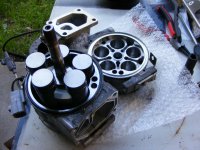 144-diyaudio.jpg203.9 KB · Views: 75
144-diyaudio.jpg203.9 KB · Views: 75 -
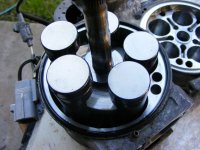 143-diyaudio.jpg168.8 KB · Views: 67
143-diyaudio.jpg168.8 KB · Views: 67 -
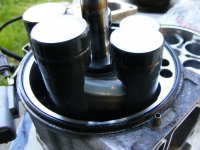 142-diyaudio.jpg171.1 KB · Views: 104
142-diyaudio.jpg171.1 KB · Views: 104 -
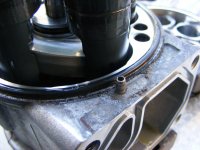 141-diyaudio.jpg170.9 KB · Views: 120
141-diyaudio.jpg170.9 KB · Views: 120 -
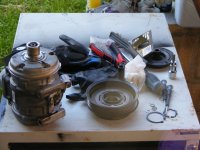 140-diyaudio.jpg179.8 KB · Views: 119
140-diyaudio.jpg179.8 KB · Views: 119 -
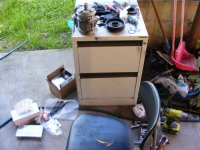 139-diyaudio.jpg246.4 KB · Views: 128
139-diyaudio.jpg246.4 KB · Views: 128 -
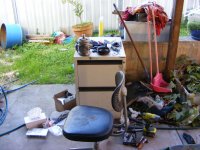 138-diyaudio.jpg256.5 KB · Views: 117
138-diyaudio.jpg256.5 KB · Views: 117 -
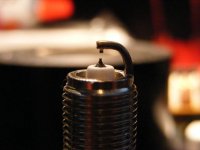 146-diyaudio.jpg97.8 KB · Views: 78
146-diyaudio.jpg97.8 KB · Views: 78
Interesting I've not seen inside a compressor before. Is it just the large O ring that you replaced or the "rings" on the pistons too?
Tony.
Tony.
You just replace the O rings, you leave the pistons alone. Actually on mine I ended up only replacing the input and output seal (in picture 8) and the shaft seal, I left the big O rings alone and I simply took them out and coated them in Nylog Red sealant in between my fingers inside of gloves and put them back in. The reason for doing this was because the old O-rings were larger than the replacements in the rebuild kit and I didn't have confidence that the new O rings would seal properly.
Before I reassembled everything I also made very sure that no dirt got into the compressor and I cleaned the outside lip with tissues and white spirits to remove any dirt away from the O ring seal areas.
I also made sure I didn't lose any pins. Basically follow the videos I link to below.
There are also some bearings on the center shaft which on mine came off a bit but I pushed them back onto the shaft with my fingers.
YouTube
YouTube
Its not a task for an amateur mechanic, you really need to know your finger skills (skills that you gather over the years of being a mechanic) and know where everything should go (namely the valve plates in the compressor need to be the right way around) to do this one properly. You also need to know the impact limits of bearings and what to do and what not to do when handling bearings.
The shaft seal is also very fragile.
YouTube
Basically a fingerprint on a shaft seal can make it start leaking. Not even kidding.
Before I reassembled everything I also made very sure that no dirt got into the compressor and I cleaned the outside lip with tissues and white spirits to remove any dirt away from the O ring seal areas.
I also made sure I didn't lose any pins. Basically follow the videos I link to below.
There are also some bearings on the center shaft which on mine came off a bit but I pushed them back onto the shaft with my fingers.
YouTube
YouTube
Its not a task for an amateur mechanic, you really need to know your finger skills (skills that you gather over the years of being a mechanic) and know where everything should go (namely the valve plates in the compressor need to be the right way around) to do this one properly. You also need to know the impact limits of bearings and what to do and what not to do when handling bearings.
The shaft seal is also very fragile.
YouTube
Basically a fingerprint on a shaft seal can make it start leaking. Not even kidding.
Last edited:
I've pulled down and rebuilt engines, but not sure I'd tackle that, anything with extremely fine tolerances I'll usually pass on 😉
Tony.
Tony.
I've pulled down and rebuilt engines, but not sure I'd tackle that, anything with extremely fine tolerances I'll usually pass on 😉
Tony.
Yeah. You've got it. I had to learn what to do and what not to do. Even using the wrong lubricant can stuff things up. Leaving oil in where the bolts go can also cause a crack on the back of the compressor housing due to hydrolocking, I put q tips in my compressors threads to soak up all of the excess lubricant, basically If you skip a step it can be disastrous for the compressor and the A/C system as a whole, that is mainly why I would recommend people shy away from it.
I don't recommend even thinking about doing it unless you happen to have the hoses and compressor and condenser out like I do and have plenty of spare time to sit there for 3-5 hours in one sitting twice over a period of 2 days to make sure the A/C compressor rebuild is all done properly. That is how long it took me and I'm not including the week of time that I had to wait between those 2 days for waiting for a new shaft seal to arrive because I put the old one in backwards and subsequently had to destroy it trying to remove it back out of the front housing of the compressor with a screwdriver and hammer.
Only reason why I replaced the shaft seal and did the rebuild on the A/C compressor was because my system is gone completely to gas and the condenser and the hoses both need replacing and all of the O-rings everywhere on the car (wherever hoses meet one another) need replacing already because the system has never been serviced before, its all original and the hoses are leaking and that could cost me heaps at an A/C shop.
So if you are doing a full restore on the car AND the A/C system has already outgassed then you should even consider doing an A/C compressor rebuild yourself AND even then think twice about it because a small piece of dirt or sand in that compressor can cause quite a few problems (score a bore for example, get stuck in the shaft seal). It isn't that difficult to take the A/C compressor down to a shop and get them to do the rebuild for you. Or you can get a new rebuilt one on ebay.
And even after all of that I still have to take it to an A/C shop to get them to flush it out and put new lubricant in it because I don't know the amount of lubricant to add to the system, well I do, but I'm not experienced in filling an A/C system with lubricant so I'll leave that job to an expert. The fear is that I will end up adding too much or too little to the system if I did it myself.
Last edited:
- Home
- Member Areas
- The Lounge
- The car thread
